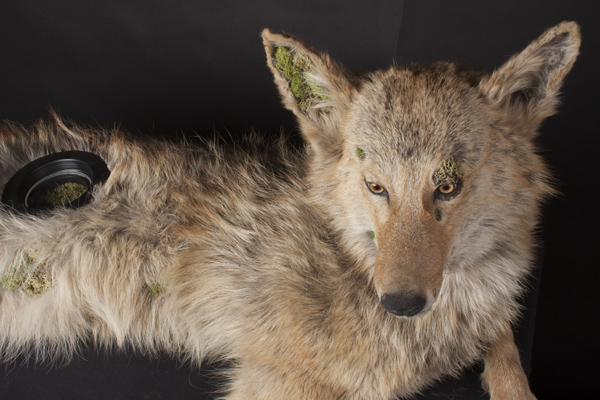
Katie Innamorato understands that growth can come from decay.
The fifth-year sculpture major’s Bachelor of Fine Arts (BFA) thesis exhibition, “Fauna and Flora,” explores the cyclical nature of life and death while also working with the idea of documentation and remembrance.
The title, which comes from two Latin words meaning wildlife and plants, directly relates to the pieces in her show where she weaves plants, such as moss and ferns, into her mount pieces — a taxidermied coyote and deer.
Innamorato, a member of the Minnesota Association of Rogue Taxidermists, said she began collecting roadkill in high school because she “likes animals a lot” and felt bad seeing them on the side of the road, but only started to experiment with taxidermy three years ago.
“I just collect weird stuff, so roadkill kind of fit in,” she said. “I thought that if it’s fresh enough I should try to use the whole thing and not waste anything.”
In her work, Innamorato said she mostly uses roadkill and scrap skins that she gets from the garment industry or other taxidermists. She said she can get skins for cheap when slippage — when hair falls off in certain areas, the carcass sits too long or the animal is hit by a car — occurs.
“[The skins] are not prepped for taxidermy, so that’s more work on my end, but I like working with specimens like that,” Innamorato said. “People give me slipped skin all the time or things with missing parts. I don’t mind people that hunt, but I don’t want an animal to be killed for me to do my work, so I try to utilize what’s already out there.”
One of the show’s aesthetic inspirations was cannulation, or the process where a surgical incision cut into an animal’s stomach provides a window where digestion can be studied. Innamorato said the “bizarre” visual was the “perfect” way to incorporate a living terrarium inside her mounts, as well as making the moss seem like it’s growing internally rather than externally.
“My coyote piece for the show has a little cannulated piece in its side and it has living mosses that you can mist,” she said. “And the deer [is] laying on its side…and it also has a little hole in its side and a fern growing from it. You have to water it and [there’s] a glass dome around it to keep it humid.”
Even though she started working on this specific project this semester, Innamorato said her work has “all been leading up to this” and she even exhibited a few cannulated pieces at a show in Los Angeles last semester.
“For that show, I did a few shoulder-mount pieces that you hang on the wall that had little holes in their chests that had moss in them, but I wasn’t really completely happy with the outcome,” she said. “I was just trying to figure out the specific way for me to create this vision I had and it took me basically all semester to finally figure it out — to sit down and go through materials, figure out what would look best and figure out how to install everything.”
Along with the larger mounts, Innamorato said she has created numerous, smaller death masks, which is her way to document and remember the animals she works and comes into contact with.
“Death masks were traditionally done when a family member or celebrity died and I thought it was a really interesting way to document the animals, what they look like when I get them,” she said. “A lot of times they’re perfect, but sometimes they’re messed up. I just wanted to show them how they are.”
Innamorato said her artistic process involves a lot of trial and error as she tries to work through all the ideas floating around in her head.
“I’m not really the type of person that sketches things out,” she said. “Usually things just pop into my head and I create them. I see things that I like aesthetically and my mind creates its own vision of that. I’ve been going through a specific aesthetic process and I think I finally got to a point where I’m happy. I’m proud of it.”
Looking toward the future, Innamorato said she plans to do an extended series of mounts similar to the ones featured in “Fauna and Flora,” and in January 2013 her work will be featured on the Science Channel’s “Odd Folks Home,” a spin-off of “Oddities,” a show she has previously been featured on.
The reception for her BFA show will be on Friday, Dec. 7 from 5 to 7 p.m., and will be on exhibition until Dec. 11, at the Dorsky.

